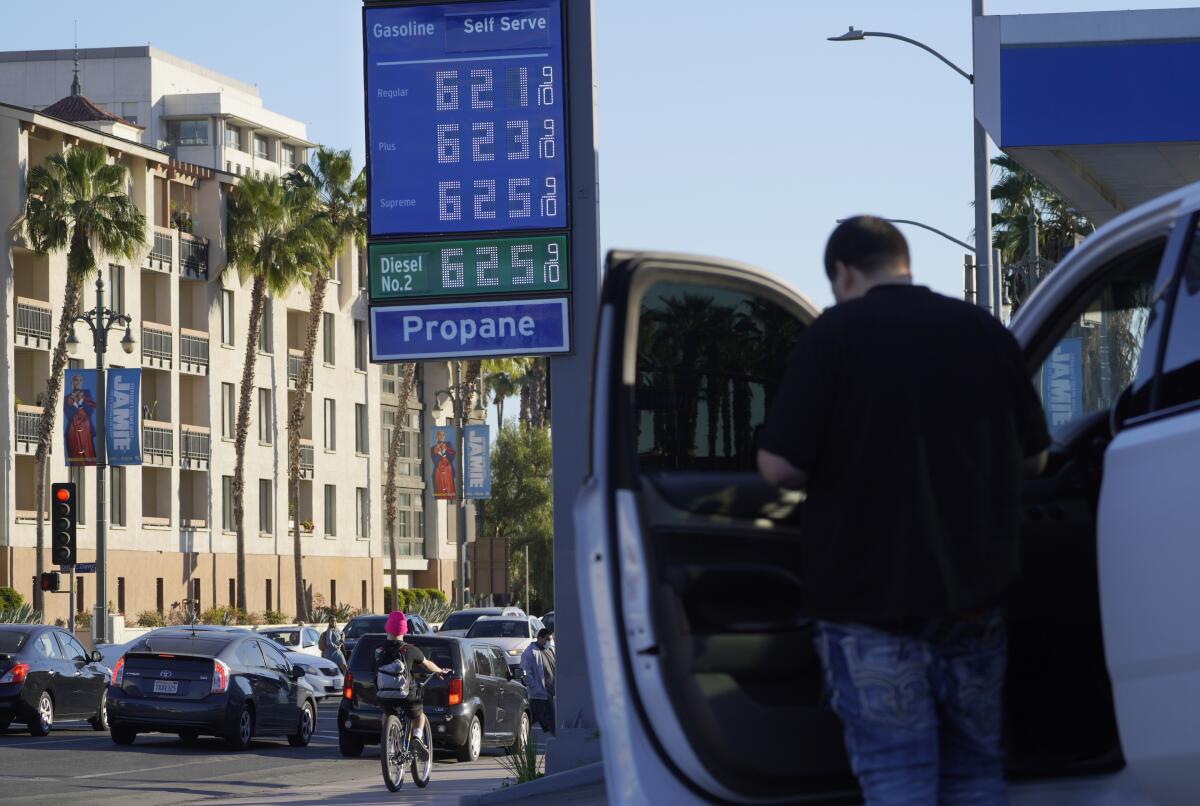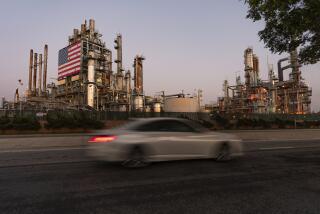Column: No, gas prices aren’t really at a ‘record.’ But people are hurting anyway

- Share via
With the price of a gallon of crude oil spiking, you’ll be reading and seeing lots of reports about gasoline prices setting records in the United States.
That’s true up to a point, but mostly not true. The difference is how you account for inflation.
Nominal prices — the number you see on the gas pump when you’re filling up — are hitting what appear to be unprecedented levels. As of Tuesday morning, the American Automobile Assn. pegged the national average at $4.173 a gallon and the California average at $5.444.
This is a step that we’re taking to inflict further pain on Putin. But there will be costs as well here in the United States.
— President Biden, announcing a U.S. embargo of Russian oil
When accounting for inflation, however, today’s prices are still about 20% below the 2008 peak on the national level and 7% below the California record that year.
That doesn’t mean that prices today aren’t inflicting real pain in consumers’ wallets, since what one pays for gasoline today comes out of one’s wages or savings today.
The more money that flows to gas companies, the less families have for necessities — food, rent, clothing — as well as leisure activities such as dining out or taking vacations.
Get the latest from Michael Hiltzik
Commentary on economics and more from a Pulitzer Prize winner.
You may occasionally receive promotional content from the Los Angeles Times.
Moreover, increases in the price of oil percolate through the economy at large, driving price increases in a universe of commodities and manufactured goods. A near-time spike in oil will show up as inflationary pressure almost everywhere.
Nor is the run-up in oil and gasoline prices likely over. The main reason is easy to discern on the front page of daily newspapers and on cable news: Russia’s war on Ukraine. Petroleum is Russia’s leading export, with the European Union and China its top customers.
Sanctions imposed on Russia by the U.S. and European Union had not included oil or natural gas, in part because Europe depends on the Russian supply through the winter and spring heating seasons. President Biden, however, announced an embargo on U.S. purchases of Russian oil Tuesday as part of the international effort to choke off Russia’s financial resources.
Are inflation fears unreasonable? It depends on how you’re spending your money.
The move won’t have much of a direct impact on American oil supplies, since Russia accounts for only 3% of U.S. oil imports and 1% of the crude processed by U.S. refineries. (More for refineries on the West Coast and Gulf Coast.) But it injected another destabilizing concern into international oil markets, where the price of crude has been hovering near $130 a barrel. Prices at the pump closely track the spot market for crude.
“This is a step that we’re taking to inflict further pain on Putin,” Biden said Tuesday in announcing the embargo. “But there will be costs as well here in the United States.”
Even before the Russian attack on Ukraine, oil and gasoline prices were in an inflationary spiral. The main reason was that the ebbing of the pandemic had spurred more economic activity, and oil-producing nations hadn’t stepped up production to meet the demand.
It’s worth noting too that not everyone is feeling pain from higher oil prices. Big multinational oil companies have been exploiting the run-up in the price of crude to line their pockets. Chevron, for example, recorded a profit of $5.1 billion on $48.1 billion in sales in the last quarter of 2021, which ended Dec. 31, compared with a loss of $6.7 billion on $34.6 billion in sales in the last pre-pandemic quarter, the fourth quarter of 2019.
ExxonMobil reported a similar trend line, with profit rising to $8.9 billion on sales of $85 billion in the fourth quarter of 2021, from profit of $5.7 billion on sales of $67.2 billion in the same quarter two years earlier.
The share prices of both companies have been on a tear so far this year — higher crude oil prices are always appreciated by their investors. Chevron’s shares have risen more than 40% and ExxonMobil‘s about 35% this year. Those are profits you’re feeding at the pump.
For all that, it may be useful to place today’s gas prices in an inflation context. Adjusted for inflation, the price of a gallon has been remarkably consistent from 1978 through 2020, from about $2.25 to $2.37 per gallon in 2020 dollars. In nominal terms — that is, the prices people see at the time — there have been spikes and slowdowns. But they tend to even out over the long term.
By that measure, current average gas prices haven’t yet reached an inflation-adjusted peak.
The latest inflation numbers shocked even pessimistic economists, but they’re still transitory.
In 2008, the last major run-up in gas prices, the national average reached a record $4.114 a gallon and California gas reached a record $4.588. In 2008 prices, today’s national average would be $3.26 and the California price $4.26.
To look at things the opposite way, the 2008 record of $4.114 would translate to about $5.26 in today’s prices and the California record of $4.588 would be $5.83.
One shouldn’t overlook that American consumers have been lulled by relatively low gas prices in recent years into complacency about what they’re driving. Average automobile mileage has been creeping upward, from 20 miles per gallon in 2008 to 29 mpg in 2020 for midsize cars, and from about 14 to 18 mpg to 24 mpg for standard sport utility vehicles.
But SUVs grew from about 27% of U.S. car sales in 2010 to 48% in 2018, which muted the trend to thriftier driving. Filling a standard SUV’s gas tank, which can hold from about 20 to as many as 33.5 gallons, will cost anywhere from $83.50 to $140 at the national average price, and $109 to $182 at the California average.
That’s enough to make any consumer take notice, even without watching TV reporters standing in front of the most expensive gas stations in the region so they can point to signs advertising $6 and $7 gas.
Electrification of the national car fleet will help wean Americans from gasoline, but up to now the transformation has been slow. All-electric vehicles accounted for less than 2% of new car sales in 2020, though the share may rise faster in the near future as more manufacturers bring out EV models.
More to Read
Get the latest from Michael Hiltzik
Commentary on economics and more from a Pulitzer Prize winner.
You may occasionally receive promotional content from the Los Angeles Times.













